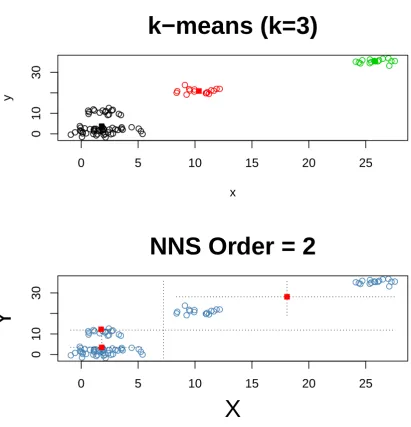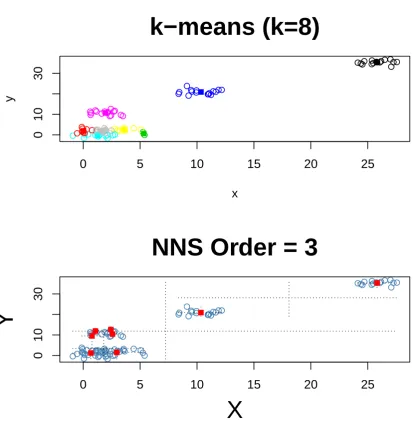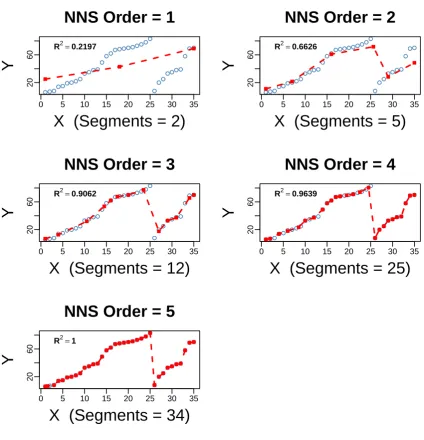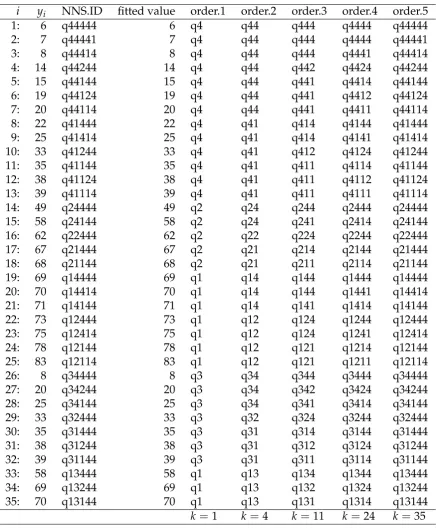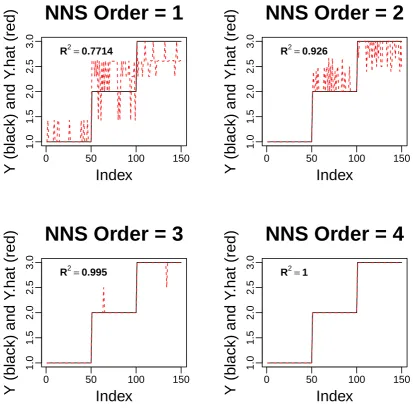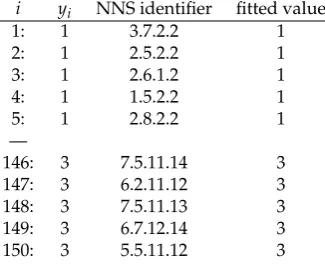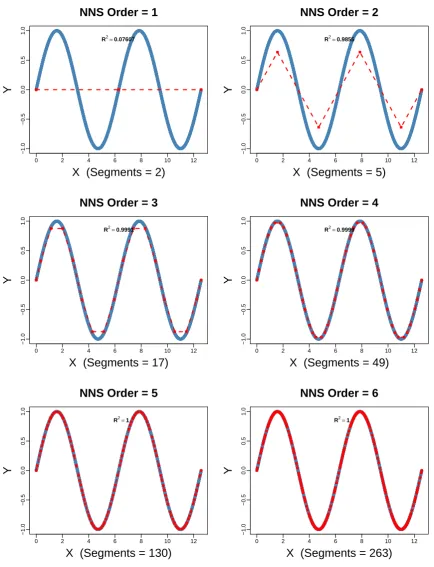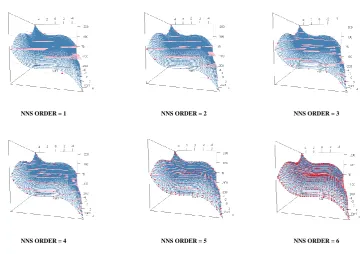Hrishikesh D. Vinod1,†,‡and Fred Viole1,‡
1 Fordham University; vinod@fordham.edu; fviole@fordham.edu
* Correspondence: vinod@fordham.edu; Tel.: +1-718-817-4065 † Current address: 441 E Fordham Rd, Bronx, NY 10458
Abstract: Nonlinear nonparametric statistics (NNS) algorithm offers new tools for curve fitting. 1
A relationship betweenk-means clustering and NNS regression points is explored with graphics 2
showing a perfect fit in the limit. The goal of this paper is to demonstrate NNS as a form of 3
unsupervised learning, and supply a proof of its limit condition. The procedural similarity NNS 4
shares with vector quantization is also documented, along with identical outputs for NNS and a 5
knearest neighbours classification algorithm under a specific NNS setting. Fisher’s iris data and 6
artificial data are used. Even though a perfect fit should obviously be reserved for instances of high 7
signal to noise ratios, NNS permits greater flexibility by offering a large spectrum of possible fits 8
from linear to perfect. 9
Keywords: clustering; curve fitting; nonparametric regression; smoothing data; polynomial 10
approximation 11
1. Introduction 12
In a recent paper [1] demonstrate a nonlinear regression (NNS) algorithm comprised of partial 13
moment quadrant means originally presented in [2]. NNS quadrant means are generated according to 14
an order parameterO, such that 4(O−1)quadrant means are calculated from a hierarchical partitioning 15
internally used with partial moment statistics. Central to this technique is the claim and proof that 16
linearly connecting these quadrant means will perfectly fit any underlyingf(x)in the limit at some 17
finiteO. 18
Our motivation for writing this paper is as follows. Polynomial type curve fitting methods claim 19
only approximate results. Any bandwidth-based nonparametric regression, illustrated by the popular 20
R package (np), [3] does not enjoy perfection because bandwidths apply to variablexfor all values of 21
x–not tailor-made for each observation. Nadaraya-Watson type kernel regression users must choose 22
both a kernel function (e.g. Gaussian) and a bandwidth parameterh. These choices are subject to a 23
well-known trade-off. Ashtends to zero, the bias diminishes but variance increases. NNS algorithm, 24
also available as an R package is subject to a similar trade-off, but contains features mitigating both 25
concerns while retaining the perfect fit ability. The variance in NNS is reduced due to the use of linear 26
segments between regression points. The bias can be reduced by increasing the number of regression 27
points (and by extension linear segments) used in the estimate. Of course this bias reduction comes at 28
the expense of increasing variance, but the linear segments do not permit much variability of estimates. 29
The claim that kernel methods are intrinsically approximate can be verified as follows. Assume we want to approximate a densityφ(x)defined as the limit of the central difference among (cumulative)
distribution functionsΦ:
φ(x) =lim h→0
1
h Φ
x+h 2
−Φ
x−h
2
. (1)
The histogram method of density estimation counts the number of data points of the underlying 30
random variableXlying in the neighbourhood of a specific valuexand divides by the bandwidth 31
h. Rosenblatt suggested replacing the central difference with a kernel weight function, which is 32
symmetric with positive variance and integrates to unity. A normal kernel defined by weightswt 33
obtained from the standard normal density,K(wt)∼N(0,σ2), also has positive variance and integrates
34
to unity, besides being so simple. Hence, a popular method in kernel density estimation is to substitute 35
wt= (xt−hx), wherexis the point at which the function is evaluated andxtare nearby observed data 36
points, into the familiar normal density formula. 37
Since all kernel functions are continuous probability distributions, the probability that a point 38
exactly equals a particular value (limiting data value)xt is always zero. Even if the kernel based 39
regression asymptotically approaches the correct value for somex, it can never achieve the exactx 40
for all observations at the same time. Furthermore, if one employs the popular leave-one-out-cross 41
validation,xtis removed from the analysis, thus guaranteeing the estimate will not exactly equalxt 42
since, again, the probability of a specific point in a continuous distribution of surrounding points is 43
equal to zero. This manuscript explains how (i) NNS converges to the exact fit for all observations 44
simultaneously in both uni- and multivariate cases, and (ii) NNS limit is achieved in finite steps, not 45
asymptotically. 46
We admit that a perfect fit versus an exceptionally good fit may seem like splitting hairs. However, 47
the former affords greater flexibility by offering a large spectrum of possible fits from linear to perfect. 48
Such flexibility in turn allows NNS to use an internal dependence measure to ascertain the signal to 49
noise ratio (SNR) and restrict the order accordingly. Spline interpolation shares this approach, albeit 50
with different techniques. Splines can fit any f(x)in a similar limit condition whereby the number 51
of knots (analogous to NNS quadrant means) will equal the number of observations. One popular 52
method to avoid overfitting with splines is to impose a penalization upon the piecewise polynomial 53
components to optimize the fit. A linear spline is defined as 54
f(x) =β0+β1x+
K
∑
i=1
bi(x−ki)+,
wherebirefers to the weight of each linear function and(x−ki)+refers to theith linear function with 55
a knot atki. The weights are then chosen by satisfying 56
K
∑
i=1
b2i <C,
whereCis a penalization criteria. But again, there is no agreed upon best method to determine an 57
optimal penalization criterion. NNS’s proposed use of dependence for this task has the benefit of being 58
objective and admitting replicable results. 59
Our free parameter SNR also permits future independent research to be seamlessly incorporated 60
into the NNS algorithm, should further advances present themselves. Bandwidth selection and kernel 61
functions are comparatively mature in their development cycles without much room for theoretical 62
advancement. When SNR is large (small) the NNS algorithm will use a larger (smaller) parameterO 63
implying shorter (longer) linear segments. Low SNR requires a greater need to avoid overfitting. 64
[1] offer a complete analysis of goodness of fits and partial derivatives against varying degrees 65
of noise, while noting the NNS dependence with each experiment. They find NNS R2 results 66
are not uniformly equal to 1, even though they have the capability to be, and note how partial 67
derivative estimation is better served with lower orders in the presence of noise, that NNS dependence 68
compensates for. Our section 3 illustrates practical advantages of NNS over the myriad of competitors 69
in regression problems, emanating from its perfect fit capability achieved relatively fast and rather 70
simply. This section also notes the similarities NNS shares with vector quantization per [4] and [5]. 71
One illustration uses a progression of partial moment quadrants alongside their linear segments to 72
highlight the piece-wise linearity of the NNS fit which enables interpolation and extrapolation along the 73
fitted lines. Thus, the NNS linearity fills a long-standing gap in the literature since inter-extra-polations 74
functions despite subtle difference in initial parameter specification. 77
1.1. k-means Objective 78
Thek-means objective is to identifyksetsSiof clusters and pointsxbelonging to each cluster 79
which minimizes the within-cluster sum of squares: 80
arg min
S k
∑
i=1x
∑
∈Si||x−µi||2. (2)
1.2. NNS Objective 81
The NNS partition dual objective is to identify setSi where each cluster results from a partial 82
moment quadrant and to identify pointzthat minimizes the within quadrant sum of squares. 83
arg min
z k
∑
i=1x
∑
∈Si||x−zi||2. (3)
Since the arithmetic mean (µ) is a least-squares estimator, this satisfies the minimization of the
84
within-quadrant sum of squares objective, thuszi =µifor any given quadrant. 85
1.3. Weirstrass Approximation Theorem 86
Weierstrass’ (1885) famousApproximation Theoremstates that any continuous function (f(x)) can be approximated arbitrarily closely by a polynomial (pn(x)) of a sufficiently high degree (n). That is,
given a compact setKso thatx ∈ K, ande >0, there exists annoffering a “close" approximation
defined by:
d(f,pn) =sup x∈K
|f(x)−pn(x)|<e. (4)
1.4. Implications 87
Unlike polynomial approximations, NNS offers a perfect, not approximate, limiting fit to f(x) denoted byfO(x), for a finitely large order parameterO. That is, given a compact setKso thatx∈K,
there exists a finitely largeOsatisfying:
d(f,fO) =sup x∈K
|f(x)− fO(x)| →0. (5)
The proof is straightforward. We start with observed values ofxand f(x). AsOincreases, the number 88
of sets and line segments joining set means increase exponentially according to 4(O−1), until each 89
observation becomes its own set mean in the limit. 90
Because NNS increases exponentially from a base of 4, this finite limit conditionOwill occur 91
much more quickly than a corresponding polynomial degree. Then, f(x) = fO(x)must hold, implying 92
a perfect fit in the limit. Similarly in a limit condition,k-means will have every observation occupy 93
its own cluster, demonstrating an equivalence to NNS quadrants. Uni- and multivariate examples 94
demonstrating NNS fitting and quadrants (clusters) in this limit condition follow from [6]. 95
The plan of the remaining paper is as follows. Section2considers a somewhat hard nonlinear 96
univariate curve-fitting problem for a distinctly clustered dataset. It conveys through a series of images, 97
the relationship betweenk-means and NNS clusters. Section3explores the relation between clusters 98
and curve fitting via linear segments. We also note the procedural similarities NNS shares with vector 99
2. NNS andk-means Clusters Visualization 101
We created a distinctly clustered dataset to present a progression of clusters in Figures 1:3 using 102
the samekfor bothk-means and NNS. 103
0
5
10
15
20
25
0
10
30
k−means (k=1)
x
y
0
5
10
15
20
25
0
10
30
X
Y
NNS Order = 1
0
5
10
15
20
25
0
10
30
k−means (k=3)
x
y
0
5
10
15
20
25
0
10
30
X
Y
NNS Order = 2
0
5
10
15
20
25
0
10
30
k−means (k=8)
x
y
0
5
10
15
20
25
0
10
30
X
Y
NNS Order = 3
Figure 3.k=8 fork-means and NNS partitioning. As the number ofkincreases, NNS andk-means will generate more identical points.
Figure1reveals that thek-means cluster and NNS clusters are identical for thek=1 case. Figures 104
2and3depict thek=3, 8 cases. Several shared points in the upper right section of Figures 1 and 3 are 105
visible. 106
3. NNS Clusters and NNS Regression 107
This section explores the relation between NNS clusters and NNS line segments used for curve 108
fitting. Figure 4 displays two columns having three figures each. The original univariate data (provided 109
in the Supplementary MaterialA) are displayed in all six figures, showing a large dip after a peak at 110
x=25. The filled-in squares in all figures represent the cluster means. The right hand figures show 111
regression fit as straight lines joining NNS quadrant (cluster) means equal to ¯X, ¯Yand end points 112
which are determined from another internal NNS algorithm described in [1]. 113
Figure 5 extends the right hand panel of Figure 4 for ordersO= 1, . . . , 5, so that it ultimately 114
0 5 10 15 20 25 30 35
20
60
X
Y
NNS Order = 1
0 5 10 15 20 25 30 35
20
60
NNS Order = 1
X (Segments = 2)
Y
R2=0.2197
0 5 10 15 20 25 30 35
20
60
X
Y
NNS Order = 2
0 5 10 15 20 25 30 35
20
60
NNS Order = 2
X (Segments = 5)
Y
R2=0.6626
0 5 10 15 20 25 30 35
20
60
X
Y
NNS Order = 3
0 5 10 15 20 25 30 35
20
60
NNS Order = 3
X (Segments = 12)
Y
R2=0.9062
Figure 4.Nonlinear data, NNS Clusters and fitted regression lines along the right hand column for
0 5 10 15 20 25 30 35
20
60
NNS Order = 1
X (Segments = 2)
Y
R2=0.2197
0 5 10 15 20 25 30 35
20
60
NNS Order = 2
X (Segments = 5)
Y
R2=0.6626
0 5 10 15 20 25 30 35
20
60
NNS Order = 3
X (Segments = 12)
Y
R2=0.9062
0 5 10 15 20 25 30 35
20
60
NNS Order = 4
X (Segments = 25)
Y
R2=0.9639
0 5 10 15 20 25 30 35
20
60
NNS Order = 5
X (Segments = 34)
Y
R2=1
The NNS algorithm assigns each observation a special identification number reflecting the 117
quadrant where it ultimately falls. In vector quantization, this step is analogous to the “codebook" 118
which represents the “codevectors". The codevectors are the segment means from a vector quantization 119
partitioning, and are very similar to NNS cluster points as defined above. Again, the primary difference 120
is the lack of an initial specification of a number of desired points for NNS. The sequence of partitioning 121
and assignment of quadrant identifications for each observation is included here for completeness. 122
Table 1 presents the special identification numbers for our univariate example in the limit 123
condition, that is forO = 5. Column 1 is the observation number, column entitled “y” has values 124
of the dependent variable, “quadrant” is the sequence of clusters assigned to each observation and 125
the “fitted value” column contains the NNS predictions ˆy. Columns 5:9 are entitled “order.O” for the 126
relevant order and lists the special identification numbers mentioned above. 127
In the third column entitled “quadrant”, the format “q...” describes the sequential partitions. For 128
the first observation, “q44444” was first assigned a partition “4”, as noted in column “order.1”. The 129
final digit 4 is the latest quadrant assignment for the last “order”, which isO=5 here. The bottom 130
row of Table 1 reportsk≤4O−1, the number of nonempty quadrants. 131
The internal NNS numbering of quadrants is not of theoretical significance. NNS uses 1=CUPM 132
(North East quadrant); 2=DUPM (North West quadrant); 3=DLPM (South East quadrant); 4=CLPM 133
(South West quadrant). The rationale behind bookending the CUPM and CLPM with the lowest and 134
highest assignments respectively is computational ease via “min” and “max” commands if those 135
quadrants should be called. For example, our first observation is consistently in the lower left CLPM 136
or fourth quadrant after 5 iterative partitions. These are also used in multivariate dependence defined 137
Table 1.Quadrant (cluster) identification for univariate example whereO=5. Sequence of quadrant identifications asOincreases andkas the number of non-empty quadrants including endpoints for eachO.
i
y
iNNS.ID
fitted value
order.1
order.2
order.3
order.4
order.5
1:
6
q44444
6
q4
q44
q444
q4444
q44444
2:
7
q44441
7
q4
q44
q444
q4444
q44441
3:
8
q44414
8
q4
q44
q444
q4441
q44414
4:
14
q44244
14
q4
q44
q442
q4424
q44244
5:
15
q44144
15
q4
q44
q441
q4414
q44144
6:
19
q44124
19
q4
q44
q441
q4412
q44124
7:
20
q44114
20
q4
q44
q441
q4411
q44114
8:
22
q41444
22
q4
q41
q414
q4144
q41444
9:
25
q41414
25
q4
q41
q414
q4141
q41414
10:
33
q41244
33
q4
q41
q412
q4124
q41244
11:
35
q41144
35
q4
q41
q411
q4114
q41144
12:
38
q41124
38
q4
q41
q411
q4112
q41124
13:
39
q41114
39
q4
q41
q411
q4111
q41114
14:
49
q24444
49
q2
q24
q244
q2444
q24444
15:
58
q24144
58
q2
q24
q241
q2414
q24144
16:
62
q22444
62
q2
q22
q224
q2244
q22444
17:
67
q21444
67
q2
q21
q214
q2144
q21444
18:
68
q21144
68
q2
q21
q211
q2114
q21144
19:
69
q14444
69
q1
q14
q144
q1444
q14444
20:
70
q14414
70
q1
q14
q144
q1441
q14414
21:
71
q14144
71
q1
q14
q141
q1414
q14144
22:
73
q12444
73
q1
q12
q124
q1244
q12444
23:
75
q12414
75
q1
q12
q124
q1241
q12414
24:
78
q12144
78
q1
q12
q121
q1214
q12144
25:
83
q12114
83
q1
q12
q121
q1211
q12114
26:
8
q34444
8
q3
q34
q344
q3444
q34444
27:
20
q34244
20
q3
q34
q342
q3424
q34244
28:
25
q34144
25
q3
q34
q341
q3414
q34144
29:
33
q32444
33
q3
q32
q324
q3244
q32444
30:
35
q31444
35
q3
q31
q314
q3144
q31444
31:
38
q31244
38
q3
q31
q312
q3124
q31244
32:
39
q31144
39
q3
q31
q311
q3114
q31144
33:
58
q13444
58
q1
q13
q134
q1344
q13444
34:
69
q13244
69
q1
q13
q132
q1324
q13244
35:
70
q13144
70
q1
q13
q131
q1314
q13144
k
=
1
k
=
4
k
=
11
k
=
24
k
=
35
4. Multivariate Iris Quadrants (Clusters) 139
We use Fisher’s celebrated ‘iris’ dataset using the categorical variable “Species” as the dependent 140
variable to illustrate the multivariate case. 141
Figure 6 demonstrates the perfect fit and classification achieved by NNS along the bottom right. 142
Since multivariate clusters for four or more regressors cannot be visualized, we presentY and ˆY 143
categorical predictions but plots actual values. 146
0 50 100 150
1.0
1.5
2.0
2.5
3.0
Index
Y (b
lack) and Y
.hat (red)
NNS Order = 1
R2=0.7714
0 50 100 150
1.0
1.5
2.0
2.5
3.0
Index
Y (b
lack) and Y
.hat (red)
NNS Order = 2
R2=0.926
0 50 100 150
1.0
1.5
2.0
2.5
3.0
Index
Y (b
lack) and Y
.hat (red)
NNS Order = 3
R2=0.995
0 50 100 150
1.0
1.5
2.0
2.5
3.0
Index
Y (b
lack) and Y
.hat (red)
NNS Order = 4
R2=1
Figure 6. Progression ofOin multivariate NNS fitting. Yand ˆYare displayed (in black and red respectively) for ‘iris’ dataset containing 4 regressors.
The quadrant identifications assigned by NNS for the corresponding regressor for the iris data are 147
tabulated next. Table 2 shows the truncated output of the multivariate NNS classification usingO=4. 148
Column 1 is the observation number, “y” is the dependent variable representing the 3 species types of 149
iris, “NNS identifier” is the sequence of identifications assigned to each observation and “fitted value” 150
is the NNS prediction of the ‘iris’ dependent variable. 151
The multivariate identifications are not simply quadrant identifications as in the univariate case. 152
These identifications are derived from the “regression point matrix” (RPM) internal to NNS, for ease 153
of reference as suggested by [8]. “Regression points” are the quadrant mean values interpreted as ˆX 154
values derived by NNS for a givenOfor all regressors in theXmatrix. The reader may benefit from 155
Since ‘iris’ has 4 regressors and 150 observations, the maximum dimensions (in the limit condition 157
whereby every observation is a quadrant mean) of the RPM will be a 150×4 (row-column) matrix. 158
The reason for these alternative identifications is straightforward, efficiency. For 4 regressors, a 159
quadrant identification ofO=4 would require 16 entries of a number 1:4 per the univariate quadrant 160
identification example immediately preceding. Whereby using the RPM, we can assign the uniqueXi 161
identification with much fewer entries even when some or all regressors have double digit entries. If 162
each regressor is aligned with its first regression pointnot partial moment quadrant, each regressor will 163
be assigned a “1”. Thus, we have only 4, not 16 digits in our NNS identifier for multiple regressors. 164
The phrase “unique observation set” refers to the dependent variableyand a matrix of regressors 165
Xfor thei-th observation,(y,X)iand the identification simply assigns the interval number(1, 2, 3, . . .) 166
along each regressor column in the RPM that correspondingXiis found.X1and the first few rows of
167
RPM are given by: 168
Sepal.Length Sepal.Width Petal.Length Petal.Width
X1 5.1 3.5 1.4 0.2
RPM: 169
Sepal.Length Sepal.Width Petal.Length Petal.Width
1: 4.300000 2.000000 1.0000 0.1000000
2: 4.612500 2.272727 1.3250 0.1852941
3: 5.012000 2.604545 1.5625 0.3000000
4: 5.388889 2.841667 1.9000 0.4000000
5: 5.704762 3.000000 3.2000 0.5500000
6: 6.057895 3.154167 3.5750 1.0000000
Now focus on the first line of Table 2 having the entry: “3.7.2.2” in the “NNS identifier” column. 170
It means the first ‘iris’ regressor “Sepal.length” was assigned a “3”, orx1=1 because its value (5.1)
171
lies within the third interval of[5.012000, 5.388889]of the first column in the RPM; the second regressor 172
“Sepal.Width” a “7”, orx2 = 1 because its value (3.5) corresponded with the 7th interval of the
173
second column in the RPM; the third regressor “Petal.Length” a “2”, orx3=2 because its value (1.4)
174
corresponded with the second interval of the third column; and the final regressor “Petal.Width” a “2”, 175
orx4=2 because its value (0.2) corresponded with the second interval of the fourth column. This set
176
of independent variables corresponded with a “setosa” species. If a new set of measurements matches 177
this partition configuration, NNS will classify it as “setosa”. The reader may immediately recognize 178
the measurement matching technique, as it will generally return the same output as the k-Nearest 179
Neighbors algorithm whenk=1. However, the goal of this paper is to demonstrate NNS as a form 180
of ‘unsupervised learning,’ or clustering. The supervised learning, or classification / multivariate 181
regression features of NNS based on these clusters suggests a strong relationship between NNS and 182
kNN, with notable differences in cluster distance weighting and the lack of restricted cluster sizes for 183
NNS. We leave the full NNS-kNN exposition for another paper. 184
As a further illustration, let us focus on the 5th line of Table 2 with “NNS identifier” value 185
“2.8.2.2” means the first ‘iris’ regressor “Sepal.length” was assigned a “2”, orx1=2 because its value
186
corresponded with the 2nd unique interval of the first column in the RPM; the second regressor 187
“Sepal.Width” was assigned a “8”, orx2=8 corresponding with the 8th interval of the second column
188
in the RPM; the third regressor “Petal.Length” a “2”, orx3=2; and the final regressor “Petal.Width” a
189
“2”, orx4=2. This set of independent variables corresponded with a “setosa” species. If a new set of
190
measurements matches this partition configuration, NNS will classify it as “setosa”. 191
Finally let us focus on the last 150-th line of Table 2 with the “NNS identifier” as “5.5.11.12”. 192
It simply means that the first ‘iris’ regressor “Sepal.length” was assigned a “5”, orx1 = 5 because
193
RPM; the third regressor “Petal.Length” equals “11”, orx3=11; and the final regressor “Petal.Width”
196
equals “12”, orx4=12. This set of independent variables corresponded with a “virginica” species. If a
197
new set of measurements matches this partition configuration, NNS will classify it as “virginica”. The 198
full table is obtained by a one-line R command from the NNS package provided in the Supplementary 199
MaterialA. 200
Table 2.Multivariate NNS partitioning and NNS.ID assignments for ‘iris’ dataset forO=4
i yi NNS identifier fitted value
1: 1 3.7.2.2 1
2: 1 2.5.2.2 1
3: 1 2.6.1.2 1
4: 1 1.5.2.2 1
5: 1 2.8.2.2 1
—
146: 3 7.5.11.14 3
147: 3 6.2.11.12 3
148: 3 7.5.11.13 3
149: 3 6.7.12.14 3
150: 3 5.5.11.12 3
Table 2 shows that the categorical variableyand the fitted value ˆyare identical, as does theR2
201
Figure6, proving a perfect fit in a finite order by NNS for the iris data. 202
4.1. Additional Visualizations 203
We present a univariate and multivariate 3d visualization of the progression of NNS fitting. 204
4.1.1. Univariate 205
The following R code is used to generate an NNS fit of increasing orders on a periodic sine wave. 206
x=seq(0,4*pi,pi/1000);y=sin(x) 207
0 2 4 6 8 10 12
−1.0
−0.5
0.0
0.5
1.0
NNS Order = 1
X (Segments = 2)
Y
R2=0.07607
0 2 4 6 8 10 12
−1.0
−0.5
0.0
0.5
1.0
NNS Order = 2
X (Segments = 5)
Y
R2=0.9855
0 2 4 6 8 10 12
−1.0
−0.5
0.0
0.5
1.0
NNS Order = 3
X (Segments = 17)
Y
R2=0.9991
0 2 4 6 8 10 12
−1.0
−0.5
0.0
0.5
1.0
NNS Order = 4
X (Segments = 49)
Y
R2=0.9999
0 2 4 6 8 10 12
−1.0
−0.5
0.0
0.5
1.0
NNS Order = 5
X (Segments = 130)
Y
R2=1
0 2 4 6 8 10 12
−1.0
−0.5
0.0
0.5
1.0
NNS Order = 6
X (Segments = 263)
Y
R2=1
Figure 7.Progression ofOin univariate NNS curve fitting of periodic sine wave.
4.1.2. Multivariate 209
The following R code is used to generate an NNS fit of increasing orders on a nonlinear 210
multivariate function. 211
f <- function(x, y) x^3+3*y-y^3-3*x 212
g <- f(z[,1],z[,2]) 215
for(i in 1:6){NNS.reg(z,g,order=i)} 216
NNS ORDER = 1 NNS ORDER = 2 NNS ORDER = 3
NNS ORDER = 4 NNS ORDER = 5 NNS ORDER = 6
Figure 8.Progression ofOin multivariate NNS curve fitting of nonlinear function. Red dots are NNS quadrant means and pink “plates” are regressor regions covered by specific NNS quadrant.
5. Conclusion 217
In conclusion, curve fitting is an old and important problem with a long history. High order 218
polynomials and kernel regressions are intrinsically approximate. This paper uses artificial univariate 219
y= f(x)data and the well-known multivariate iris data to illustrate and display how a newer NNS 220
algorithm reaches a perfect fit while using quadrants as clusters along the way. We offer analogies 221
to existing techniques such ask-means and codevectors when defining NNS clusters and explain 222
the differences in objective functions / initial parameter specifications. We also illustrate quadrant 223
identifiers internal to NNS for univariate and multivariate cases which help speed the algorithm. 224
The perfect fit in finite steps is not claimed to be directly usable in practice since some noise 225
is always present. In sampling theory sample size is sometimes determined after specifying the 226
error rate, which is possible because the perfect result (exact value of the population parameter) is 227
potentially available. We are currently working on extending NNS to nonparametric regressions, 228
providing a similar capability to first choose an error rate and then obtain a nonparametric fit. All 229
this is now feasible due to the perfect fit in relatively simple finite steps described here. In any case, 230
NNS fills a gap in the nonparametric regression literature by offering flexibility which in turn yields 231
high quality interpolation and extrapolation from a nonparametric fit illustrated in [1]. The NNS 232
identifier matrix serves the same purpose as vector quantization codebooks. Thus NNS shares a lot of 234
features with some very robust long-standing techniques while offering a slew of additional features 235
in a convenient R package. 236
Appendix. Supplemental R-Code 237
We provide all of the R-code used to produce the above examples and plots. Sincek-means is not 238
deterministic, the clustering examples may not replicate exactly to what is presented above but should 239
still sufficiently highlight the differences in objective functions. Note that the typical code involves 240
very few lines. 241
Clustered Dataset: 242
n = 100;g=6;set.seed(g) 243
d <- data.frame(x = unlist(lapply(1:g, function(i) rnorm(n/g, runif(1)*i^2))), 244
y = unlist(lapply(1:g, function(i) rnorm(n/g, runif(1)*i^2)))) 245
Figure 1 R-commands: 246
require(NNS); require(clue) 247
par(mfrow=c(2,1)) 248
plot(d, col = kmeans(d,1)$cluster, main=paste("k-means (k=",1,")",sep = ""), 249
cex.main=2) 250
points(kmeans(d,1)$centers,pch=15,col=1) 251
NNS.part(d$x,d$y,order=1,Voronoi = T) 252
Figure 2 R-commands: 253
par(mfrow=c(2,1)) 254
plot(d, col = kmeans(d,3)$cluster, main=paste("k-means (k=",3,")",sep = ""), 255
cex.main=2) 256
points(kmeans(d,3)$centers,pch=15,col=1:3) 257
NNS.part(d$x,d$y,order=2,Voronoi = T,noise.reduction = ’off’) 258
Figure 3 R-commands: 259
par(mfrow=c(2,1)) 260
plot(d, col = kmeans(d,8)$cluster, main=paste("k-means (k=",8,")",sep = ""), 261
cex.main=2) 262
points(kmeans(d,8)$centers,pch=15,col=1:8) 263
NNS.part(d$x,d$y,order=3,Voronoi = T,noise.reduction = ’off’) 264
Univariate Data Example R-command: 265
set.seed(345);x=sample(1:90);y1=sort(x[1:25]);y2=sort(x[1:10]);y=c(y1,y2);xx=1:35 266
Figure 4 R-commands: 267
par(mfrow=c(3,2)) 268
for(i in 1:3){NNS.part(xx,y,order=i,Voronoi=T,noise.reduction = ’off’); 269
NNS.reg(xx,y,order=i,noise.reduction = ’off’)} 270
Figure 5 R-commands: 271
par(mfrow=c(3,2)) 272
for(i in 1:5){NNS.reg(xx,y,order=i,noise.reduction = ’off’)} 273
for(i in 1:4){NNS.reg(iris[,1:4],iris[,5],order=i)} 276
RPM R-commands: 277
head(NNS.reg(iris[,1:4],iris[,5],order=4)$rhs.partition) 278
Table 1 R-commands: 279
order=matrix(nrow=35,ncol=5) 280
colnames(order)=c("order.1","order.2","order.3","order.4","order.5") 281
for(i in 1:5){order[,i]= 282
NNS.reg(xx,y,order=i,noise.reduction = ’off’)$Fitted.xy[,NNS.ID]} 283
cbind(NNS.reg(xx,y,order=5,noise.reduction = ’off’)$Fitted.xy[,.(y,NNS.ID)],order) 284
Table 2 R-commands: 285
NNS.reg(iris[,1:4],iris[,5],order=4)$Fitted.xy[,.(y,NNS.ID,y.hat)] 286
Even though the paper does not discuss extrapolation and interpolation of fitted nonparametric 287
regression functions in detail, the following code illustrates the ease with which these tasks are 288
implemented. (i) Interpolation and extrapolation for artificial data are illustrated by following 289
commands: 290
NNS.reg(xx,y,noise.reduction = NULL,point.est = 25.5) 291
NNS.reg(xx,y,noise.reduction = NULL,point.est = 36) 292
(ii) Illustrative Iris data interpolation and extrapolation commands are: 293
NNS.reg(iris[,1:4],iris[,5],point.est = (iris[1,1:4]+.01))$Point.est 294
NNS.reg(iris[,1:4],iris[,5],point.est = (iris[150,1:4]+1))$Point.est 295
296
1. Vinod, H.D.; Viole, F. Nonparametric Regression Using Clusters. Computational Economics, June 19, 2017 297
2017.
298
2. Viole, F.; Nawrocki, D. Deriving Nonlinear Correlation Coefficients from Partial Moments.SSRN eLibrary 299
2012.
300
3. Hayfield, T.; Racine, J.S. Nonparametric Econometrics: The np Package. Journal of Statistical Software2008,
301
27, 1–32.
302
4. Kohonen, T. The Self-organizing Map. Proceedings of the IEEE1990,78, 1464–1480.
303
5. Grbovic, M.; Vucetic, S. Regression Learning Vector Quantization. IEEE International Conference on Data 304
Mining (ICDM)2009, pp. 788–793.
305
6. Viole, F.NNS: Nonlinear Nonparametric Statistics, 2016. R package version 0.3.6.
306
7. Viole, F. Beyond Correlation: Using the Elements of Variance for Conditional Means and Probabilities.
307
SSRN eLibrary2016.
308
8. Bellman, R. On the approximation of curves by line segments using dynamic programming.
309
Communications of the ACM1961,4, 284.

